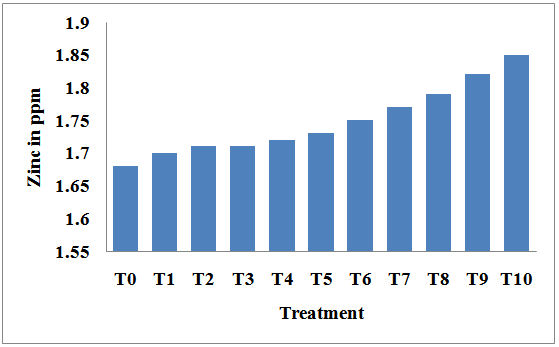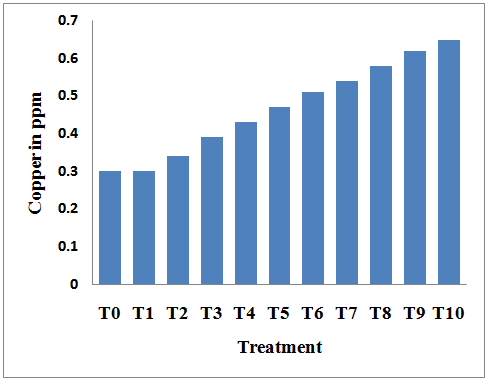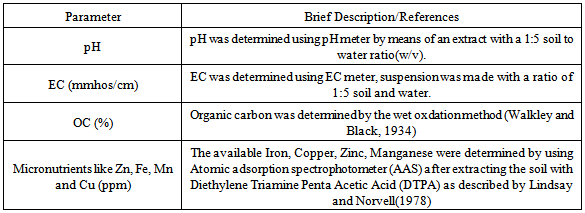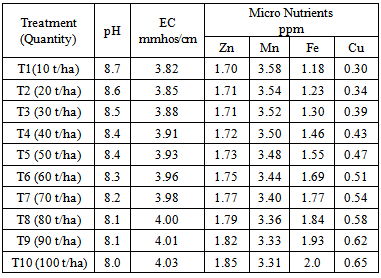-
Paper Information
- Next Paper
- Paper Submission
-
Journal Information
- About This Journal
- Editorial Board
- Current Issue
- Archive
- Author Guidelines
- Contact Us
American Journal of Environmental Engineering
p-ISSN: 2166-4633 e-ISSN: 2166-465X
2014; 4(3): 41-45
doi:10.5923/j.ajee.20140403.01
A Study on Micro-Nutrients of Alkaline Soils by Using Paddy Husk Ash
Sanjeeva Rayudu E. 1, Srimurali M. 2, Venkaiah K. 3
1Assistant Professor, Department of Civil Engineering, G.Pulla Reddy Engineering College, Kurnool, A.P, 518007, India
2Professor, Department of Civil Engineering, Sri Venkateswara University, Tirupati, A.P, 517502, India
3Professor, Department of Soil Science, A.N.G.R. Agricultural University College, Tirupati, A.P, India-517502, 517502, India
Correspondence to: Sanjeeva Rayudu E. , Assistant Professor, Department of Civil Engineering, G.Pulla Reddy Engineering College, Kurnool, A.P, 518007, India.
| Email: |  |
Copyright © 2014 Scientific & Academic Publishing. All Rights Reserved.
Alkaline soils are known to adversely affect agricultural crop productivity. Problems commonly attributed to such soils include high value of pH, nutrient deficiency, poor structure and less soil microbes. The present study communicates the amelioration of micro-nutrients of alkaline soils by the application of Paddy husk ash obtained from rice mill. In this investigation, studies were conducted for identification of alkaline soils and also analyzation of industrial wastes of paddy husk ash to assess its potentiality for micronutrients amelioration of alkaline soils, for agricultural purpose. Paddy husk ash wastes contain significant quantities of micro nutrients like Ferrous, Zinc, copper, and Manganese which are quite essential for agricultural soils. Hence, amelioration studies were conducted by treating the alkaline soil with paddy husk ash quantities ranging from 10 to100 ton/ha. A number of pH, EC, and micronutrient properties were investigated. From this study, it is revealed that the micronutrients of alkaline soils like zinc, copper, ferrous and EC values were improved and values of pH and Manganese decreased. The study also estimated, the quantities of paddy husk ash required for amelioration of micronutrients in alkaline soils.
Keywords: Paddy husk ash, Alkaline soils, Micronutrients and pH
Cite this paper: Sanjeeva Rayudu E. , Srimurali M. , Venkaiah K. , A Study on Micro-Nutrients of Alkaline Soils by Using Paddy Husk Ash, American Journal of Environmental Engineering, Vol. 4 No. 3, 2014, pp. 41-45. doi: 10.5923/j.ajee.20140403.01.
Article Outline
1. Introduction
- Rapid increase in the population and urbanization in the past decades and the consequent increase in food demand of the growing world population has resulted in a large increase in the demand for food production. Land is the most vital resource of any country. It is a fixed asset and cannot be expanded to meet the needs of an increasing population. Therefore, it must be used carefully and in the best possible manner.In is estimated that a vast area around 952 million hectares all over the world is affected with alkalinity or salinity or both (Gupta and Gupta, 1984). A large area in India, nearly 9.38 million hectare is occupied by salt-affected soils out of which 3.88 million hectares are alkaline soils and 5.5 million hectares are salinity soils (Gopikannan and Ganesh 2013).Some industrial wastes contain valuable material and some times, are being used or reused in unscientific manner or many times placed in wrong place completely, posing a great hazard to the human environment. Hence, balanced utilization and management of disposable wastes has assumed importance, in order to prevent environmental pollution and to conserve the resources (Sanjeeva Rayudu E et al. 2013).Micronutrients are play a key role in many metabolic processes such as respiration, fixation and photosynthesis (Mengal and Kirbay 1987). Micronutrients enter into the soil system through different pathways including agricultural additives such as lime, manure, fertilizer, herbicides, fungicides and irrigation waters as well as through potentially deleterious materials such as municipals composts, sewage sludge, industrial and mine wastes, dredged materials and atmospheric deposits (Berrow 1986). In the soil, micronutrients are adsorbed and retained by the inorganic colloids and organic soil (Bride, 1986) and then supplied to the plants for essential metabolic processes and enzymatic reactions to occur (Adrian, 1986). The micronutrients like Zinc (Zn) and copper (Cu) are adsorbed by soil colloids and soil organic matter and known to exist as exchangeable ions. Although, they do form insoluble compounds, their availability in soils is not generally controlled by precipitation. However, chemistry of other minerals like Iron (Fe) and Manganese (Mn) in soils is largely governed by precipitation reactions. Soil pH and oxidation-reduction status exert a major influence on the availability of Fe and Mn (Bernad et al., 1990).The current study deals with the use of paddy husk ash, from rice mill waste, for micronutrients amelioration in alkaline soils. Values of Zinc, Copper, Iron and pH in determine the helpfulness of soil for agricultural and other purposes.
2. Materials and Methods
2.1. Materials
- The alkaline soils used in this study were obtained from Gajulamandaym village, near Tirupati, Chitoor district, Andhra Pradesh, India. Samples taken from the upper 30 cm soil layer were sieved (2mm diameter sieve) to increase the uniformity of experiment and were analyzed for various parameters as per the standard procedures (Tandon 2004). The details of parameters and testing procedures adopted along with relevant references are presented in table.
|
2.2. Experimental Setup
- A study was carried out under laboratory conditions. Paddy husk ash was mixed thoroughly at different proportions with alkaline soils, sample of each mixer were placed in plastic trays (30 cm x30 cm x15 cm length, width and height) and maintained 39% field capacity for 90 days curing period (Scott et al. 1996). Soil samples were analyzed after curing and evaluated for best proportion of husk ash yielding optimal amelioration of soil. Finally a quantity of paddy husk ash is to be applied for amelioration of alkaline soils for agricultural purpose was established.
3. Results and Discussion
- Industrial wastes have got a vast potential for amelioration of wastelands, which are excessively present. The industrial wastes have diverse characteristics of parameters, which are considered to be useful for agricultural purpose. Hence, in the present work an attempt has been made to ameliorate micronutrients of alkaline soils near Gajulamandyam, Tirupati with the available local industrial waste, paddy husk ash. This was done, taking into consideration the critical/sensitive parameters required for soil remediation based on requirement for land fertility. The results are presented in tabular form and illustrated in graphical form also. These are followed by discussion.
3.1. Nature of soil
- Several chemical properties of the soil were evaluated and they are presented in table 2.
|
3.2 Nature of Industrial Waste
- Results of analysis of studies carried out on industrial wastes are presented in the table 3.
|
3.3. Treatment with Paddy Husk Ash
- Selected alkaline soil was blended with paddy husk ash in ten different proportions and was kept for curing period of 90 days. After treatment, the results of analysis presented Table 4 with followed by discussion.
|
3.3.1. pH
- As the quantity of effluent increased, the pH value decreased gradually from 8.8 to 8.0. The decreasing of trend of pH values is due to application of low pH paddy husk ash and is beneficial from the nutritional point of view and improves them by crop growth.
3.3.2. Electrical Conductivity (EC)
- The EC values of treated alkaline soil enhanced from 3.82 to 4.03mmhos/cm. This was mainly due to accumulation soluble salts that are present in paddy husk ash. Electrical conductivity crossed the threshold value at 4mmhos/cm at higher dose of paddy husk ash, beyond 80 ton/ha. If EC value more than 4mmhos/cm will affect critical growth of sensitive crop in soil (Duel 2009).
3.3.3. Micro Nutrients
- Micronutrient elements are required by plants in very low concentration suggests that they all function as catalyst or at least closely linked with some catalytic process in plants. Micronutrient elements include copper, zinc, iron, manganese.
3.3.3.1. Available zinc
- The available Zn in the soil is 1.68 ppm and is above critical level as per the rating chart (Soil Health card 2010). The data presented in Figure 1, revealed that the Zn content of the treated alkaline soil progressively improved with different proportion of paddy husk ash and enhanced 1.68 to 1.85ppm. As per critical limit value of 0.60 mg/kg as established by Lindsay and Novell (1978) all the treated soil had shown sufficiency in relation to crop growth. The higher Zn in treated alkaline soils obtained during study might be due to presence of considerable amount of Zn (3 ppm) in the paddy husk ash used for treatment.
 | Figure 1. Variation of soil Zinc at different proportions of paddy husk ash |
3.3.3.2. Available Manganese
- The available Mn in the soil is 3.60 ppm and is above critical level (2.0 ppm) as per the rating chart (Soil Health card 2010). An examination of the data presented in Figure 2, revealed that Mn content of alkaline soil of was progressively decreased with the different proportions of treated husk ash. Mn content decreased from 3.60 ppm to 3.31 ppm. All the treated alkaline soils were sufficient in available magnesium content. The decrease Mn value in treated alkaline soils obtained during study might be due to low concentration of Mn (1.4 ppm) in the paddy husk ash used for treatment.
 | Figure 2. Variation of soil Manganese at different proportions of paddy husk ash |
3.3.3.3. Available Iron
- Available iron in the soil is 1.18 ppm and is below critical level as per rating chart (Soil Health card 2010). An examination of data presented in Figure 3, indicated that available iron content in the treated soils varied from1.18 to 2.0 with different proportion of paddy husk ash. This might be due to the presence of rich iron content in the paddy husk used in this study.
 | Figure 3. Variation of soil Iron at different proportions of paddy husk ash |
3.3.3.4. Available Copper
- The available copper in the soil 0.30 ppm and is above critical level as per the rating chart. It is evident from the data presented in Figure 4, indicated that the available copper content in the treated alkaline soil increased with increase in dosage of paddy husk ash. The copper content enhanced from 0.30 ppm to 0.339 ppm.
 | Figure 4. Variation of soil copper at different proportions of paddy husk ash |
4. Conclusions
- Overall, the present study revealed that the alkaline soils, when treated with paddy husk ash, responded favorably, in terms of amelioration. Blending/treatment of alkaline soil resulted in substantial improvement in micronutrients like Zn, Cu and Fe and EC properties of the soil. The study also revealed that values of pH and Mn substantially reduced. However, the Electrical Conductivity was also gradually increased and was beyond the limit of Electrical Conductivity 4 mmhos/cm (L.E Duel and G.H. Holliday 2009) after treatment 8(T8). Hence it can be established that 80 ton/ha of paddy husk ash is required for amelioration of alkaline soils for agricultural purpose.
 Abstract
Abstract Reference
Reference Full-Text PDF
Full-Text PDF Full-text HTML
Full-text HTML


